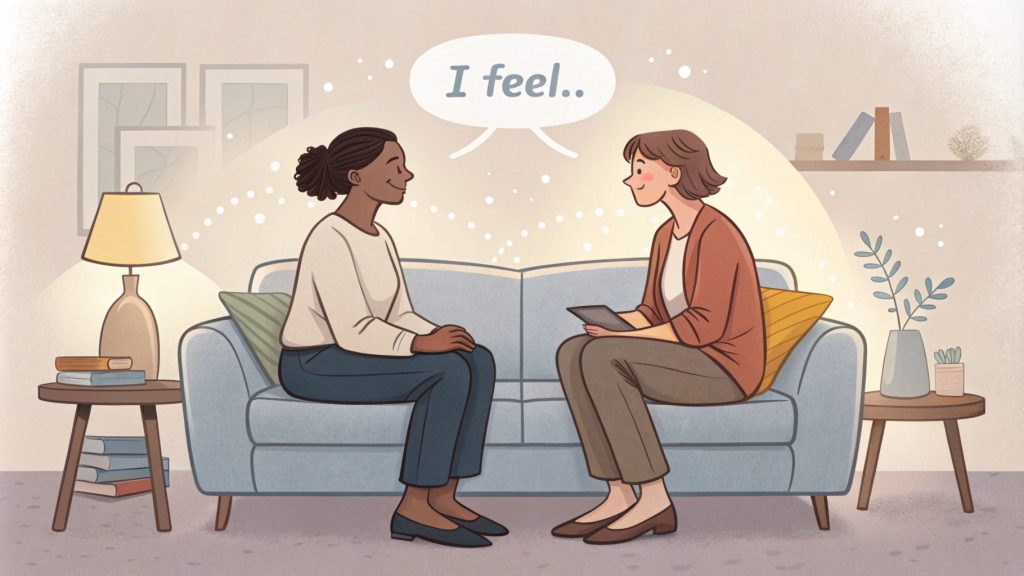Expressing feelings openly and honestly forms the foundation of healthy relationships. Yet many people find their attempts to share emotions quickly spiral into heated arguments. This common challenge can leave both parties feeling frustrated, misunderstood, and disconnected.
Communicating feelings effectively without triggering conflicts requires understanding the delicate balance between self-expression and empathy. While it’s natural to want to defend one’s position, the key lies in creating a safe space where both individuals can share their perspectives without judgment. When emotions run high, stepping back and approaching conversations with patience and understanding can prevent unnecessary tension.
Understanding the Difference Between Expression and Argumentation
Emotional expression and argumentation serve distinct purposes in communication. Their core objectives differ fundamentally: expressing feelings aims to share personal experiences, while argumentation focuses on proving points through logical reasoning.
Why Emotional Expression Often Escalates to Conflict
Emotional expressions transform into arguments when defensive reactions override empathetic listening. Research indicates a direct correlation between detected emotions during debates and the emergence of conflicting opinions, leading to negative emotional responses. Common escalation triggers include:
- Misinterpreting emotional vulnerability as criticism
- Responding to feelings with counter-arguments
- Shifting from sharing experiences to proving who’s right
- Taking personal expressions as direct attacks
- Emotional messages get distorted through defensive filters
- The focus shifts from understanding to winning
- Personal feelings become weapons in debates
- Active listening diminishes as defensive responses increase
- Communication patterns become cyclical and unproductive
| Communication Element | Impact on Emotional Expression | Impact on Argumentation |
|---|---|---|
| Emotional Content | Supports authentic connection | Creates tension points |
| Purpose | Share personal experience | Establish correctness |
| Outcome | Mutual understanding | Win-lose dynamic |
The Art of Expressing Feelings Effectively
Effective emotional expression requires specific communication techniques to prevent conversations from escalating into arguments. These techniques focus on clarity, timing, and personal accountability in emotional discussions.

Using “I” Statements
“I” statements focus on personal feelings rather than accusations toward others. Here’s how to structure effective “I” statements:
- Start with “I feel” followed by a specific emotion (frustrated, hurt, worried)
- Connect the emotion to a situation using “when” or “because”
- Avoid using “you” statements that can trigger defensiveness
- Express needs clearly without demanding changes
Examples of effective “I” statements:
- “I feel lonely when we don’t spend time together.”
- “I feel unappreciated because my efforts weren’t acknowledged.”
- “I feel frustrated when plans change without discussion.”
- Select a private location free from distractions
- Schedule discussions when both parties are calm
- Allow sufficient time for the conversation without rushing
- Avoid sensitive conversations during high-stress periods
- Choose neutral environments that don’t favor either person
- Ensure physical comfort through appropriate seating arrangements
- Pick times when energy levels are balanced for both parties
Common Pitfalls That Turn Expressions Into Arguments
Expressing feelings in a relationship often derails arguments due to specific communication patterns and behaviors. These common pitfalls create barriers to understanding and emotional connection between partners.
Blame Language and Accusations
Blame language transforms emotional expression into confrontation, creating immediate defensiveness in conversations. Instead of saying, “You never listen to me,” use “I feel unheard when interrupted during conversations.” Replace accusatory phrases with personal experience statements:
- Start sentences with “I feel” or “I experience” instead of “You always” or “You never.”
- Focus on specific situations rather than generalizations
- Express emotions directly without adding blame or judgment
- Describe the impact of actions on feelings rather than attributing motives
Bringing Up Past Issues
Introducing previous conflicts into current discussions creates compound arguments that prevent resolution. Here’s how past issues complicate emotional expressions:
- Mixing old grievances with present concerns dilutes the current topic
- Referencing past mistakes triggers defensive responses
- Multiple unresolved issues overwhelm the conversation’s focus
- Historical patterns overshadow present feelings
- Emotional buildup from past events intensifies current reactions
- Address one specific situation at a time
- Keep discussions centered on current emotions
- Separate past patterns from present circumstances
- Schedule separate conversations for unresolved issues
- Acknowledge progress made since previous conflicts
Healthy Communication Techniques
Effective communication techniques transform emotional expressions into productive conversations. These methods create a foundation for mutual understanding while preventing defensive reactions.
Active Listening Skills
- Maintain eye contact during conversations to demonstrate engagement
- Pause before responding to process the speaker’s message completely
- Reflect on what was heard using phrases like “What I understand is…”
- Ask clarifying questions to ensure accurate understanding
- Avoid interrupting or planning responses while the other person speaks
- Notice non-verbal cues such as tone changes, body language shifts
- Acknowledge emotions without judgment: “I hear you’re feeling frustrated.”
- Express understanding of their viewpoint: “It makes sense that you’d feel that way.”
- Validate experiences even when disagreeing: “I understand why this situation affected you.”
- Show empathy through supportive responses: “That must have been difficult.”
- Accept different interpretations of shared experiences
- Respond with curiosity rather than defensiveness when views differ
Each technique strengthens emotional safety, creating an environment where feelings flow freely without triggering arguments. The focus remains on understanding rather than winning, allowing both parties to feel heard and respected.
Creating Safe Spaces for Emotional Expression

Safe spaces for emotional expression enable individuals to share their feelings openly without fear of judgment or conflict. These environments promote honest communication through established guidelines and mutual trust.
Setting Ground Rules
- Establish clear communication boundaries:
- No interrupting while someone speaks
- Zero tolerance for name-calling or hostile language
- Equal time allocation for each person to share
- Phones off during discussions
- Create physical comfort:
- Choose a quiet, private location
- Maintain comfortable seating arrangements
- Set aside dedicated time without distractions
- Keep the environment at a comfortable temperature
- Define response protocols:
- Wait 5 seconds before responding
- Ask permission before offering advice
- Use agreed-upon timeout signals
- Stick to one topic at a time
- Practice gradual self-disclosure:
- Share minor concerns first
- Express appreciation regularly
- Acknowledge personal mistakes
- Demonstrate emotional availability
- Maintain emotional safety:
- Listen without judgment
- Validate expressed emotions
- Avoid minimizing feelings
- Respect confidentiality
- Demonstrate reliability:
- Follow through on commitments
- Maintain consistent responses
- Honor discussed boundaries
- Show up emotionally present
- Use collaborative language:
- “I feel hurt when…” statements
- “Help me understand…” questions
- “What I hear you saying…” reflections
- “We can work through this…” affirmations
Takeaway
Expressing feelings shouldn’t be a battleground but an opportunity for deeper connection and understanding. When individuals create safe spaces, prioritize active listening, and practice empathetic communication, they can transform potentially heated discussions into meaningful dialogues.
The path to healthier emotional expression lies in conscious choices: using “I” statements, staying focused on the present, and approaching conversations with genuine curiosity rather than defensiveness. These mindful practices pave the way for authentic connections built on trust and mutual respect.
Remember that sharing feelings isn’t about winning or losing – it’s about fostering understanding and strengthening relationships through open, honest communication.



